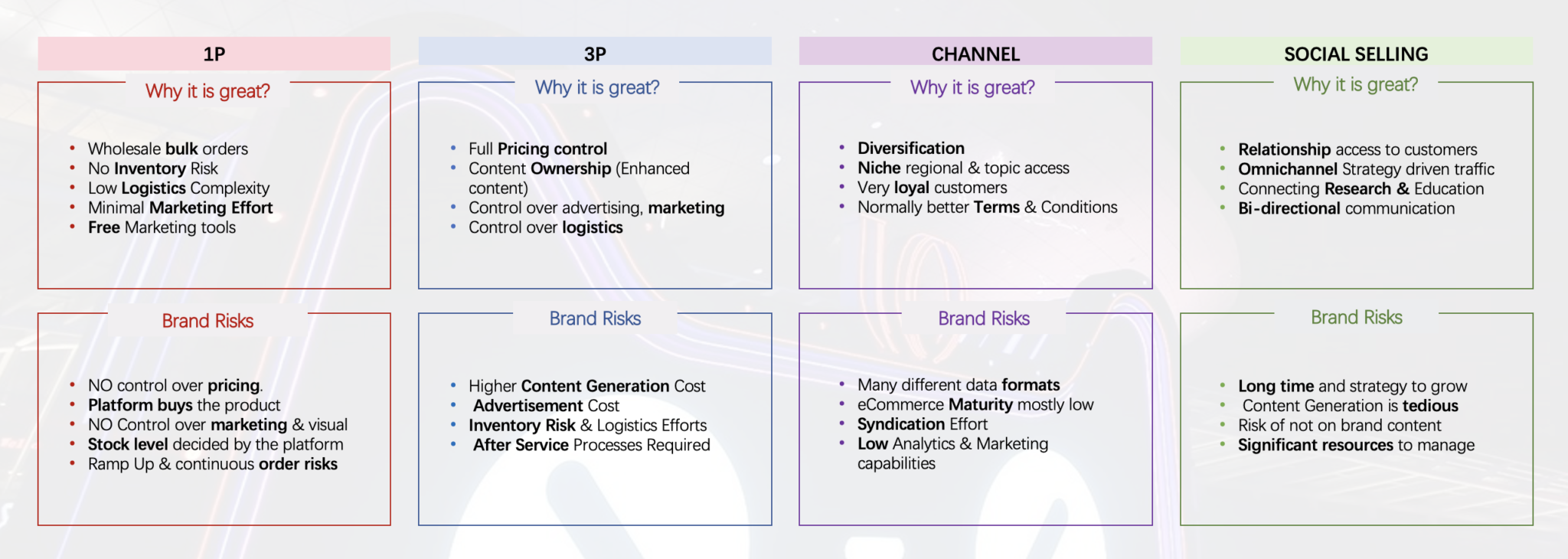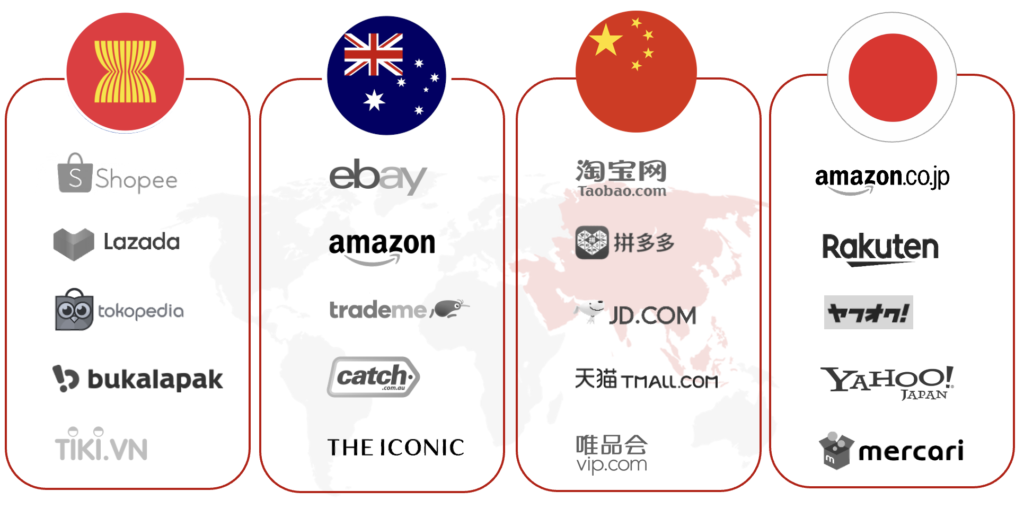
Navigation
If you are just starting to expand your channel management or are struggling to keep up with the ever growing channel flood, it’s good to evaluate the right business model for the channels you are adding to your mix.
Each channel requires different data, formats and offers slightly different business models.
Each channel and business model comes with their Pros and Cons and fit different company sizes and maturity.
Confused? Well, don’t be.
In this article, we will cover the essentials how to engage with the different marketplaces and how to build a balanced strategy beyond multiple marketplaces to reach customers and convert them to loyal customers.
So let’s get right into it.
1P Marketplaces Relationships – What are they?
1P originates from the term first-party. 1P relationships can be compared with a wholesale relationship where you are focusing on the production, design & brand of products while the whole seller is managing customer access, distribution and logistics.
In a 1P marketplace, your job is to fulfill the purchase orders you get by the platform you are selling to. How and when they sell it forward does not concern you: once you have sold the products to the platform, your job as a vendor is complete!
Additionally Amazon and Co are offering better placements, automatic addition to their Prime & Premium delivery and cover topics like tax, returns and other time consuming activities.
Sounds great? So what’s the down side?
In this business model the marketplace like amazon offer perks and make it simple for small companies to get started without a big team to manage this channel.
On the flip side the marketplace has full autonomy around the pricing, advertisement and content of your product giving you little space to engage with your customers.
This can even mean dropping your prices below MRR or Minimum Advertised Price.
In short your profit margins are suffering as you are selling at wholesale prices instead of retail prices.
Another downside is that the marketplace can control the product stock, ordering timelines and when to add or drop your products. This means that a winning streak can be ended very abrupt creating a high dependency & risk for sellers.
Why it’s great?
- Wholesale bulk orders
- No Inventory Risk
- Low Complexity around cross boarder, taxation and service
- Content & SEO efforts low
- Marketing tools from most platforms
Concerns Brands should consider:
- NO control over the product pricing.
- The platform takes over the product marketing and decides product descriptions and visual listing elements.
- Stock level decided by the platform
- Ramp up & continuous order risks
3P Models – With more power comes more responsibility
3P refers to a 3rd party business model and allows companies to directly sell and communicate with their customers putting the platform more into a middle man roll orchestration the search and sale.
3P business models are great for companies which have had some success growing their channels and have a solid channel management team in please. No the intern Christine is NOT enough.
While more than 54 % of amazon units are sold by 3P sellers in Q3 2020 it requires significant effort to build a recuring revenue model and consistent monitoring and fine tuning of your listing to ensure revenues stay up.
While becoming a 3P Seller (Beginner’s Guide: How to Sell on Amazon)requires some work upfront it allows you a much deeper control of your content and tell your brand story more vividly.
Why it’s great?
- You have more control over the pricing.
- You have more control over advertising, marketing, and logistics.
- You have more control over shipping.
- You can establish a better branding and brand identity.
- You can edit your listing, product details, and promotions at your will.
Concerns Brands should consider:
- Higher Content Generation & Advertisement Cost
- Inventory Risk & Logistics Efforts
- Depending on platform After Service Processes
Dependency & Channel Mix – How to stay competitive?
So how to reduce dependency & create a broader channel mix?
Especially in Asia major tech platforms are dominating the “path to customer” and require ever higher CAC (customer acquisition cost) cashing in on their dominant position.

DISTRIBUTOR IN ASIA - Partnerships & JVs
Classical Channel management is still strong and allows a more eye to eye relationship with the retail or channel partners. Additionally regional and niche marketplaces can be a good way to diversify your channel mix and reduce dependency on the big 4-5 players.
ASIA BEYOND MARKETPLACES - Social Selling
Beside marketplaces and retail partners social selling is becoming more and more dominant not only for B2C but B2B scenarios allowing a more personal communication with your customers. This can happen via owned channels and shops on well known platforms like facebook or Tik Tok or via sponsored or customer generated content.
Most of the major social media platforms shifted from pure content sharing towards an eCommerce-driven business model opening store functionality.
Additionally, non Owned channels are a good way to spread the word especially in Asia where despite quiet some concerns about legitimacy of the sometimes astronomical follower & revenue numbers social business models are taking countries by storm.
Do your sales teams share their expertise already? If not let’s discuss a good strategy!
Why it’s great?
- Getting a non salesy access to customers
- Great for connecting to customers beyond transactional activities
- Connecting Research, Education with commerce element
- Bi-directional communication
Concerns Brands should consider:
- It takes time and strategy to grow these channels
- Content Generation is tedious and needs lots of creativity
- Brand language and visuals need to align the platform
- Risk of not on brand content
- Requires resources to manage the channels
BEYOND THE WESTERN WORLD - Asia Unleashed
While Amazon and Co are conquering the western world being the first channel to scale a brand in America or Europe the Asian market is way more diversified with regional leaders.

OUR TAKEWAY - Think beyond marketplaces
A well rounded Omnichannel strategy is key to utilize the right marketplaces to acquire customers but ensure that you are driving traffic to your other channels. So creating great product experiences (after service,…) ensures loyalty & engagement beyond the Point of sales allowing to connect customers to your brand permanently and win back the path to customer. Marketplaces are a great marketing channel to reach a broad or targeted audience but it requires dedication and bears a risk.
So finding an efficient strategy to optimize your channel efforts and balancing multiple channel is key to win in these channels. Interested of increasing your margins by transitioning to a 3P relationship or build a Syndication Strategy?
Need more information?
- Read our Whitepaper – Asian marketplaces your path to Asian Success?
- Read more about our Customer Success story helping companies globally (Chervon)
- YouTube the difference between PIM vs. PCM & PXM



